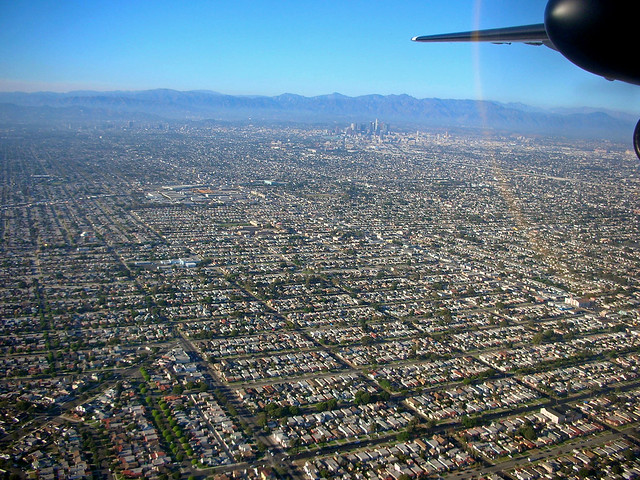 |
| The Baltimore-Washington Metro Area from Space (Washington D.C. at top of photo, Baltimore is below) Image Courtesy of NASA Johnson Space Center |
 |
| Suburban sprawl around Los Angeles Image by flickr user ATIS547 |
 |
| Abandoned row homes in BaltimoreImage by flickr user newskin0 |
The Reemergence of Cities
In recent years, the trend of suburbanization has begun to reverse itself, with growth in American suburbs beginning to slow and many big cities beginning to see their populations rise again. Between 2011 and 2012 only one of the nation's 20 largest cities (Detroit) saw it's population decline, and 16 of the 20 saw an increase in their growth rates compared to 2010-11. Among the 51 metropolitan areas with more than one million residents, 24 saw their cities grow faster than their suburbs 2011-12 with average big city growth being 1.12% and suburban growth 0.97%. Even booming Sunbelt cities such as Orlando, Austin, Atlanta, Houston, and Charlotte saw their suburbs grow slower than the cities themselves (although many Southern have a low-density, "suburban" feel/layout outside of their downtowns).
 |
| The recently developed NoMa neighborhood in Washington D.C.Image by flickr user Elvert Barnes |
The Mid-Atlantic wasn't an exception to the trend of growing urban areas. In the New York metropolitan area, New York City — the nation’s largest, with over 8 million people — saw its population grow 0.8% between July 2011 and July 2012, much faster than the 0.3% growth of its suburbs. Between 2000 and 2010, the New York metro area’s suburbs generally grew faster than New York City. Recently in the Baltimore metro area recent years, the rapid pace of growth in two suburban counties, Carroll and Harford counties slowed. In fact, Carroll County's population saw a decline from 2011 to 2012, a very rare occurrence in the Baltimore-Washington metro area. At the same time more urban counties such as Baltimore and Anne Arundel grew, as well as the city of Baltimore itself (for the first time in over 50 years). In the rapidly growing Washington D.C. Metro Area 62% of the 224,000 people who moved to Greater Washington between 2010 and 2012 moved to the city and inner suburbs.
The faster growth of large cities probably has its origins in the downturns in the national housing and labor markets of the past five years and the continued slowdown in suburban growth. Young people, retirees, and other householders who might have moved to the suburbs in better times are unable to obtain mortgages or employment. Young people especially may have put their lives on hold indefinitely because of the downturn, delaying marriage, kids and home-buying. They have also moved to cities in search of jobs, an urban lifestyle, and better nightlife. In addition baby boomers are tired of commuting and want to have easier access to events and cultural activities.
If this trend continues, and so far it has shown no signs of letting up, it could create a major shift in the "typical" American residence away from the stereotypical sterile middle-class subdivision filled with families residing in detached single-family homes with 2-car garages on cul-de-sacs to urban rowhomes, apartments, and condos near entertainment, commercial, and retail destinations and along transit routes.
No comments:
Post a Comment